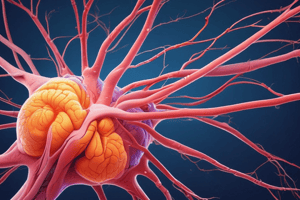Podcast
Questions and Answers
Preganglionic neurons of the sympathetic nervous system originate from the cervical and sacral regions of the spinal cord.
Preganglionic neurons of the sympathetic nervous system originate from the cervical and sacral regions of the spinal cord.
False (B)
The sympathetic ganglia are only divided into prevertebral ganglia located near internal organs.
The sympathetic ganglia are only divided into prevertebral ganglia located near internal organs.
False (B)
Postganglionic neurons of the sympathetic nervous system release acetylcholine as a neurotransmitter throughout the body.
Postganglionic neurons of the sympathetic nervous system release acetylcholine as a neurotransmitter throughout the body.
False (B)
The sympathetic nervous system primarily operates in conjunction with the parasympathetic nervous system.
The sympathetic nervous system primarily operates in conjunction with the parasympathetic nervous system.
Sympathetic innervation of sweat glands and the arrector pili muscles involves the use of acetylcholine as a neurotransmitter.
Sympathetic innervation of sweat glands and the arrector pili muscles involves the use of acetylcholine as a neurotransmitter.
The sympathetic nervous system is composed of four types of neurons: preganglionic, parasympathetic ganglionic, postganglionic, and interneurons.
The sympathetic nervous system is composed of four types of neurons: preganglionic, parasympathetic ganglionic, postganglionic, and interneurons.
Dilation of the pupils (mydriasis) allows less light to enter the eyes.
Dilation of the pupils (mydriasis) allows less light to enter the eyes.
Increased heart rate is one of the key actions of the parasympathetic nervous system.
Increased heart rate is one of the key actions of the parasympathetic nervous system.
Bronchodilation makes breathing more difficult.
Bronchodilation makes breathing more difficult.
The sympathetic nervous system increases motility in the stomach and intestines.
The sympathetic nervous system increases motility in the stomach and intestines.
Reduction in enzyme and insulin secretion is a key action of the sympathetic nervous system.
Reduction in enzyme and insulin secretion is a key action of the sympathetic nervous system.
Activation of the sympathetic nervous system can lead to high blood pressure.
Activation of the sympathetic nervous system can lead to high blood pressure.
Flashcards are hidden until you start studying
Study Notes
The sympathetic nervous system is one of the two divisions of the autonomic nervous system, the other being the parasympathetic nervous system. It plays a crucial role in regulating many functions and parts of the body, particularly when the body needs to respond quickly to stressful or dangerous situations. Let's dive deeper into the structure, function, and actions of the sympathetic nervous system.
Structure and Organization
The sympathetic nervous system is composed of three types of neurons: preganglionic, sympathetic ganglionic, and postganglionic. Preganglionic neurons originate from the thoracic and lumbar regions of the spinal cord (T1-L2). They have short axons that continue through the anterior rami of spinal nerves and then branch off to form the sympathetic ganglia. The sympathetic ganglia are further divided into paravertebral ganglia (found near the spine) and prevertebral ganglia (located near internal organs).
The postganglionic neurons receive signals from the preganglionic neurons and then travel to their respective targets throughout the body, releasing neurotransmitters like epinephrine or norepinephrine (also known as noradrenaline). However, for sympathetic innervation of sweat glands and the arrector pili muscles, acetylcholine is used instead of epinephrine or norepinephrine.
Functions and Actions
The sympathetic nervous system primarily operates in opposition to the parasympathetic nervous system, often referred to as the 'fight or flight' response. It prepares the body for immediate action in response to perceived threats or challenges. Some key actions of the sympathetic nervous system include:
- Eye: Dilation of the pupils (mydriasis) allows more light to enter the eyes, while the ciliary muscle relaxes, improving far vision.
- Heart: Increase in heart rate, force of contraction, and rate of conduction leads to increased cardiac output, supplying the body with oxygenated blood.
- Lungs: Bronchodilation and reduced pulmonary secretions facilitate easier breathing.
- Stomach and Intestines: Decreased motility and sphincter contraction slow digestion to redistribute energy to other parts of the body.
- Exocrine and Endocrine Pancreas: Reduction in enzyme and insulin secretion conserves energy.
- Urinary Bladder: Contraction of the urethral sphincter helps prevent urination.
- Renin Secretion: Kidneys produce more renin to maintain blood volume and pressure.
- Salivary Glands: Small amounts of potassium and water secreted to aid in the process of swallowing.
In addition to these actions, the sympathetic nervous system also has effects that do not directly oppose those of the parasympathetic nervous system. For example, vasoconstriction occurs in the skin, abdominal viscera, and kidney, with varying degrees of constriction in skeletal muscles.
The sympathetic nervous system plays a significant role in maintaining homeostasis under normal circumstances, but prolonged activation due to chronic stress can have negative health outcomes, such as high blood pressure, type 2 diabetes, and cardiovascular diseases.
Studying That Suits You
Use AI to generate personalized quizzes and flashcards to suit your learning preferences.




